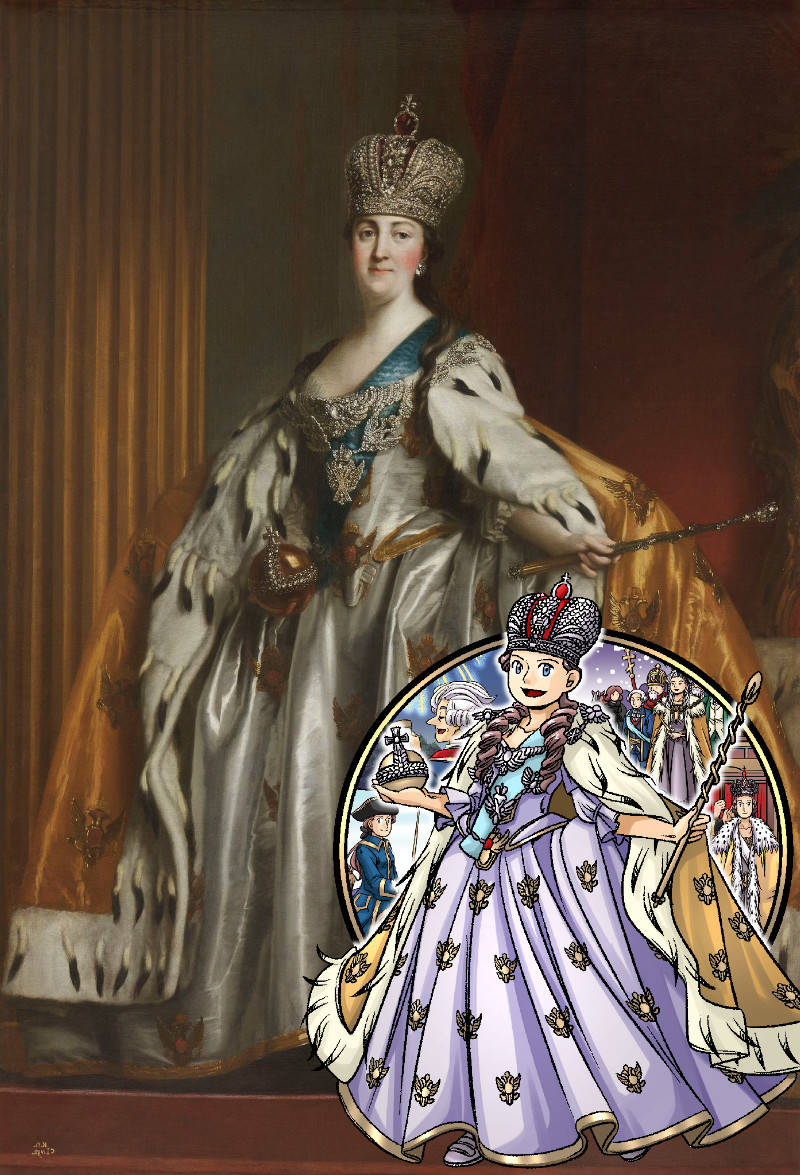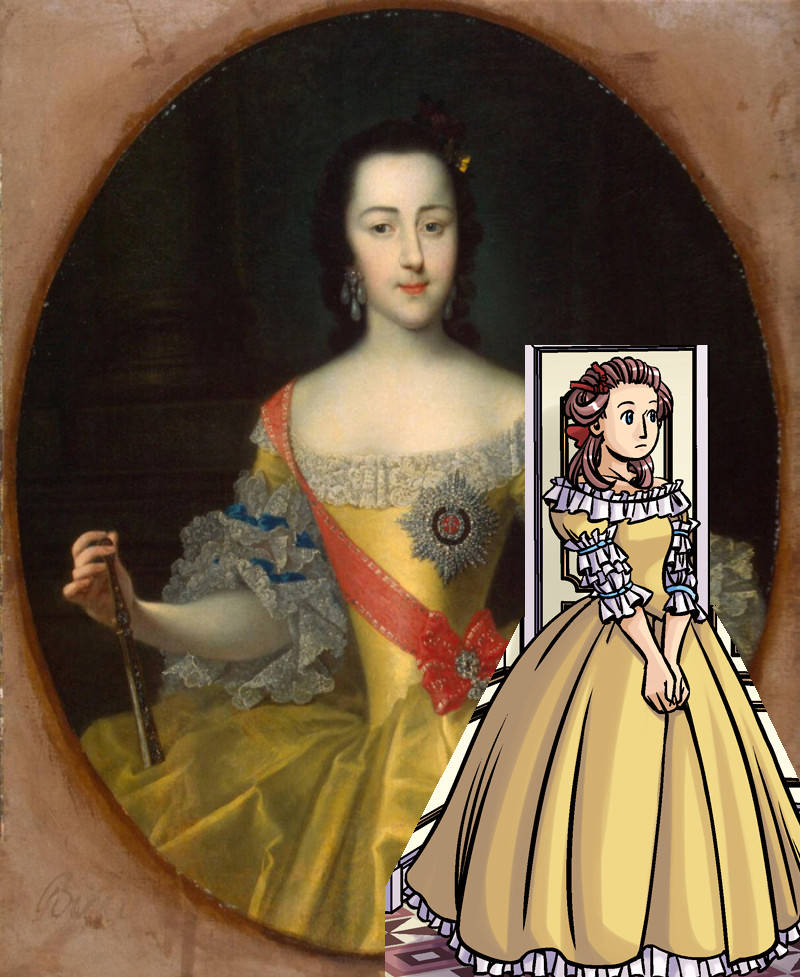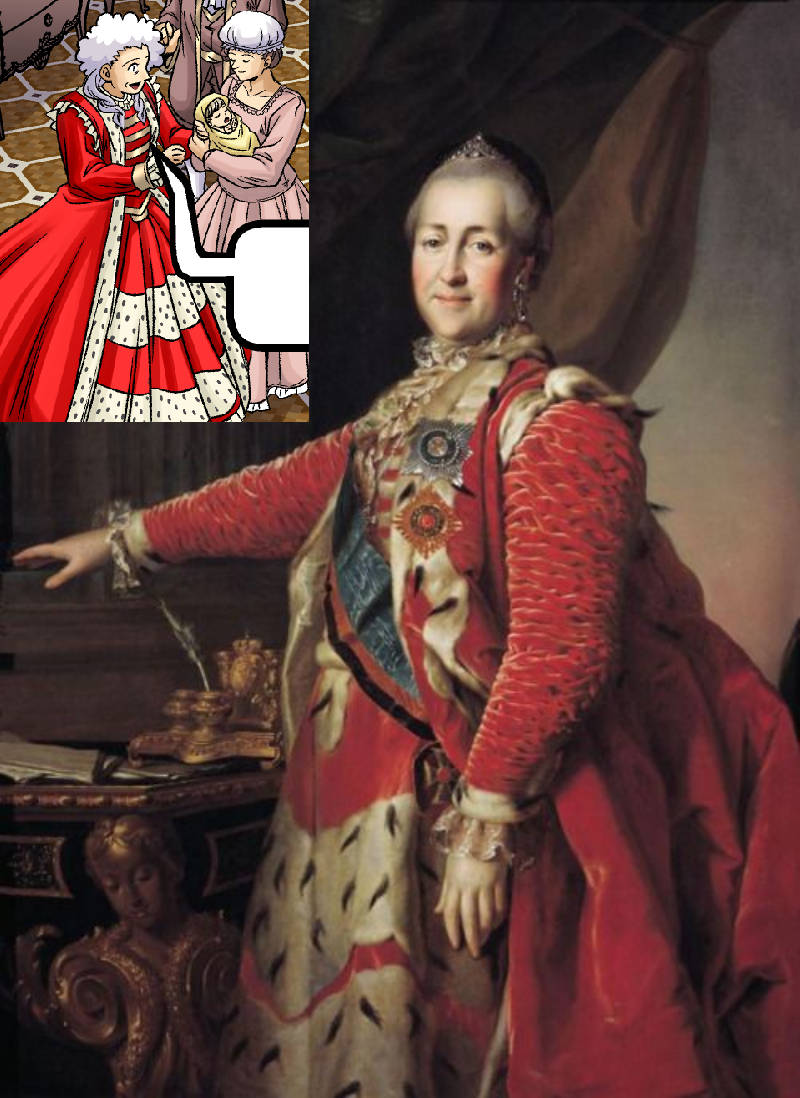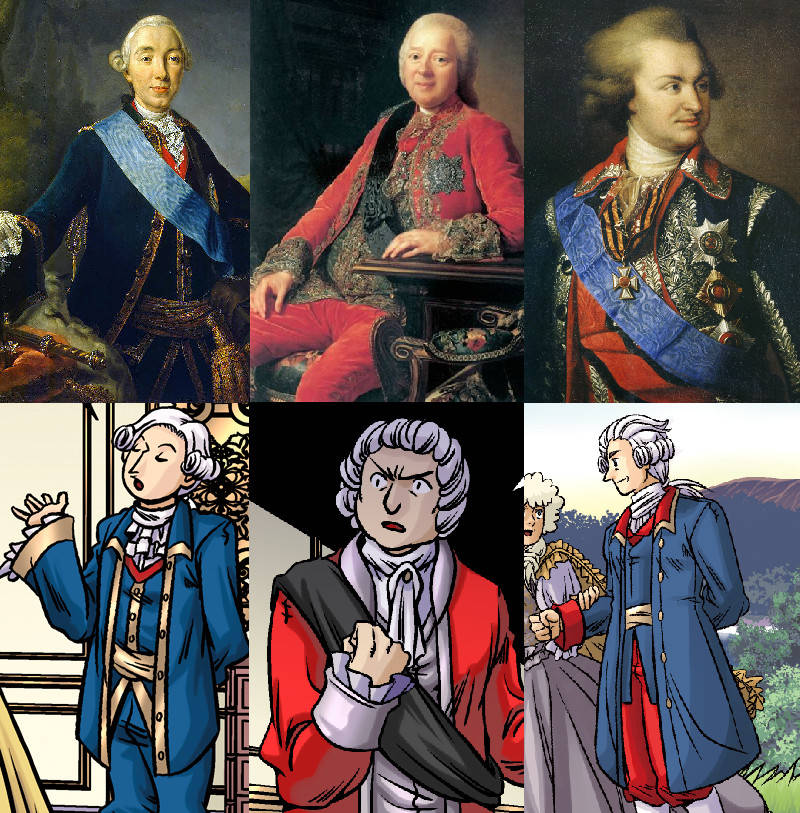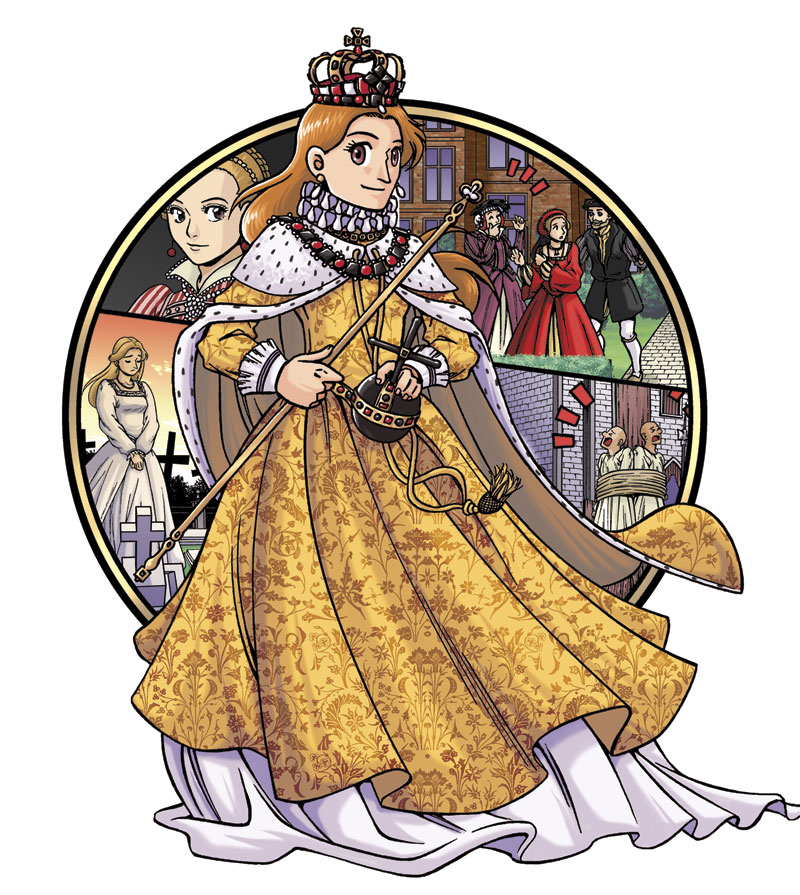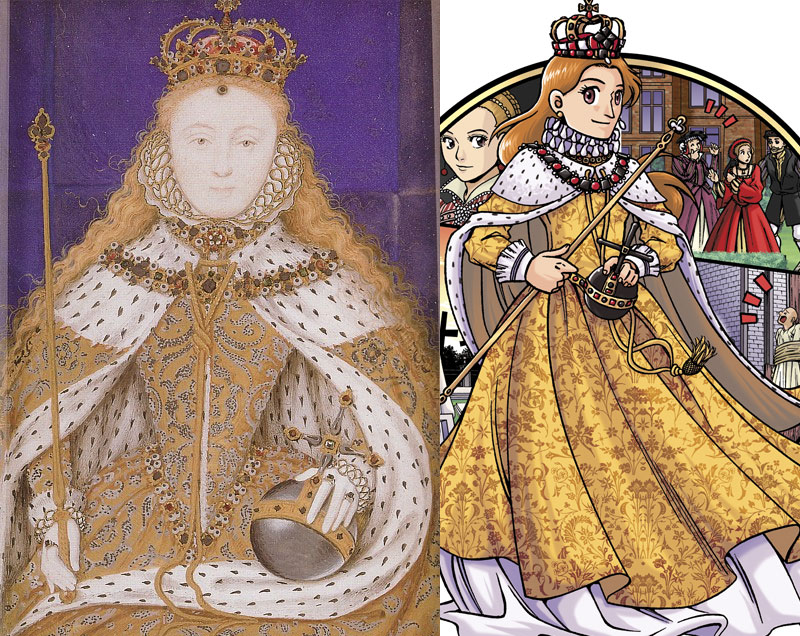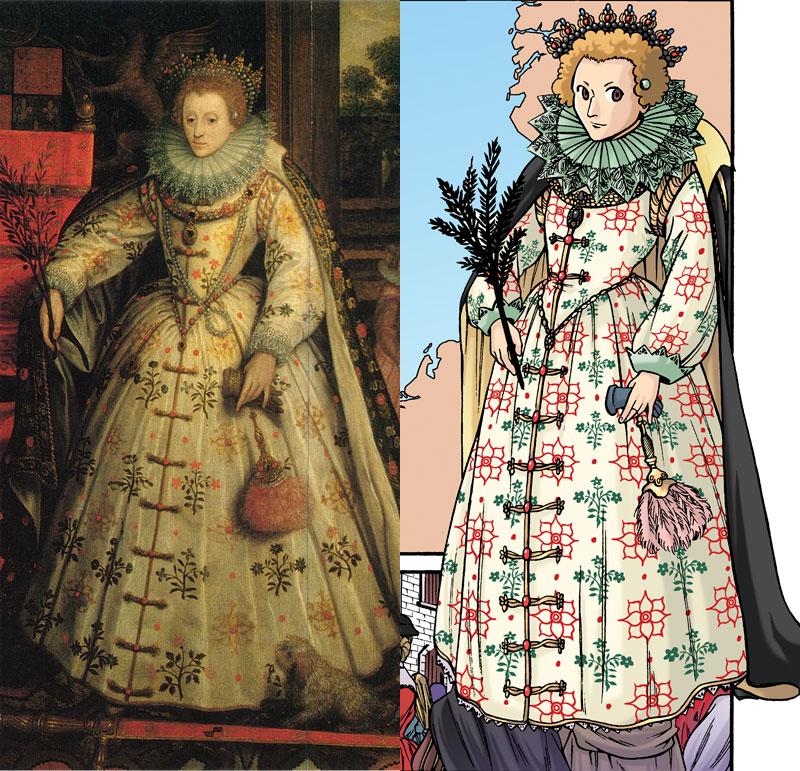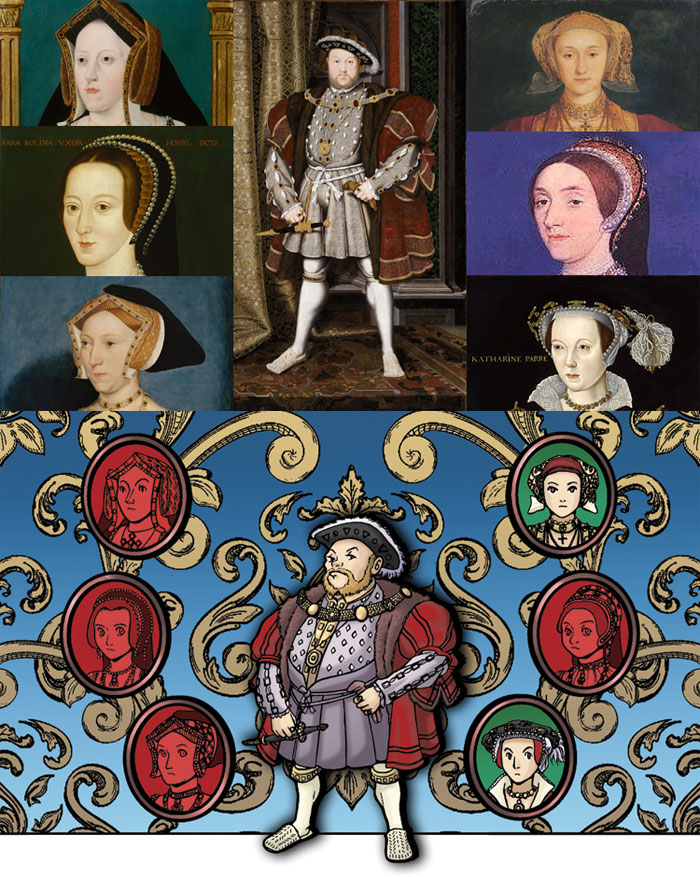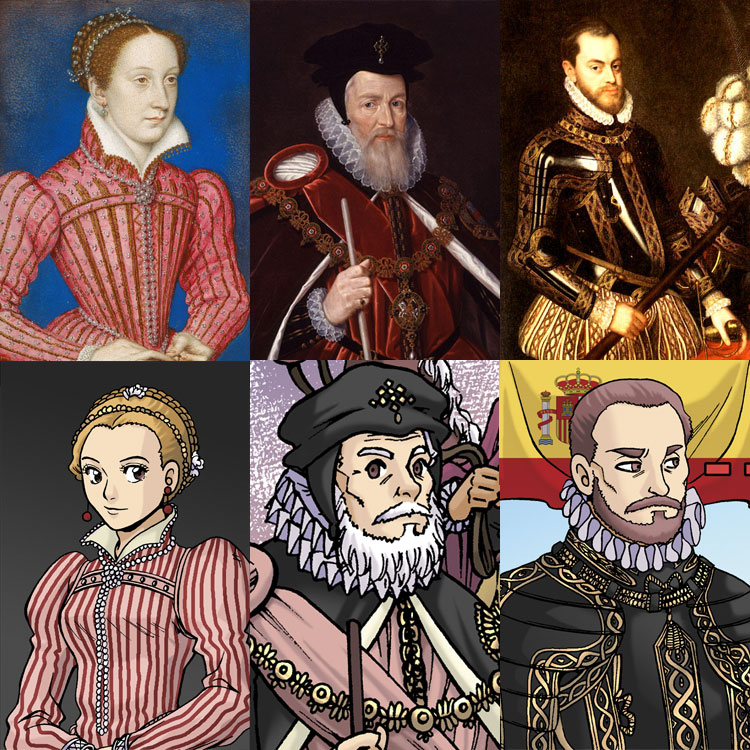Here are the footnotes and bibliography that should accompany the Catherine the Great biographical comic I created. Feel free to email me if there are corrections required. Some of the books also have multiple editions, so if you have a different edition, the page numbers may not be correct.

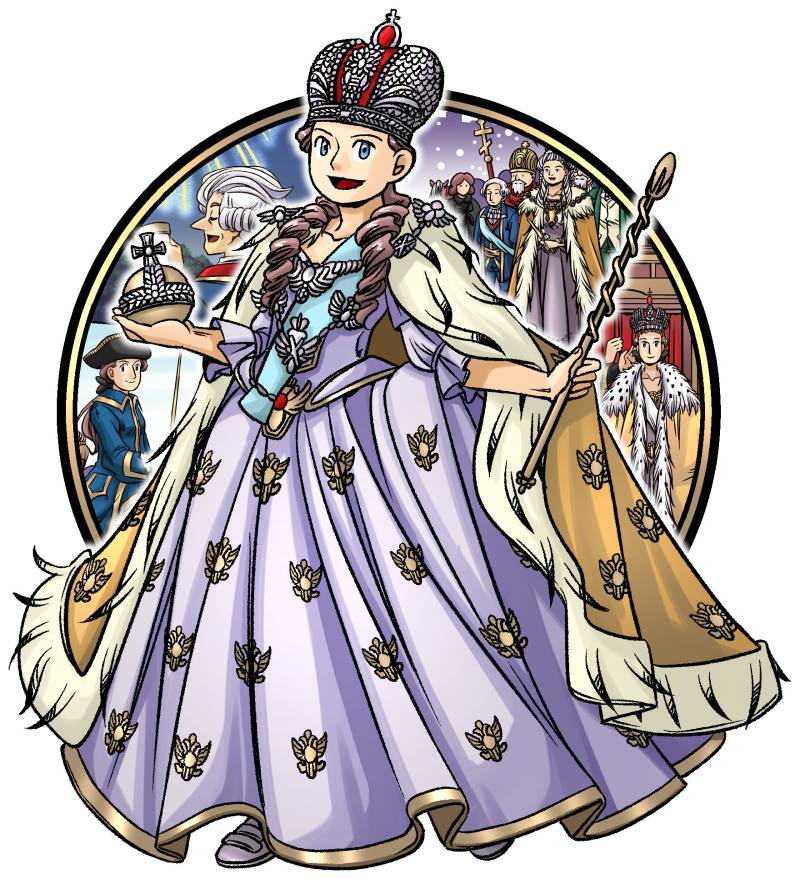

FOOTNOTES
[1] (Rounding, 2006) p7-11. (Streeter, 2007) p10-11. She was the first child of 39 year-old Prince Christian August of Anhalf-Zerbst, and 17 year-old mother Princess Johanna Elizabeth of Holstein-Gottorp. These were two of around 300 small German principalities who all fought among and intermarried with each other constantly, and for a girl of Catherine’s standing, a good marriage was important since competition was fierce. As a child, her relationship with her narcissistic mother was troubled, but she was also brought to other neighbouring courts by her mother as a child, and this familiarity with court life was invaluable training for her later life. Johanna would later go on to promote Sophia as a possible marriage candidate to the Russian court in 1743 A.D., but it was also Johanna who would later become a mild obstacle to Sophia’s marriage ambitions–possibly because she saw her daughter as a rival.
[2] (Rounding, 2006) p14. (Streeter, 2007) p8. Sophie’s connection to Empress Elizabeth came through her mother Johanna, whose principality of Holstein-Gottorp has had marriage relations with. Elizabeth’s sister Anna Petrovna was married to Duke Karl Frederick (and Prince of Sweden), and Elizabeth was previously engaged to Johanna’s older brother Prince Karl August, though that marriage did not eventuate since Karl died prematurely of smallpox. Johanna took great care to preserve and cultivate that relationship, and even named her second daughter Elizabeth after the Empress (which Elizabeth agreed to be godmother to).
[3] (Rounding, 2006) p26. (Streeter, 2007) p12. (Michael, 1986) p13. Empress Elizabeth was 34 when she met Sophie, and Sophie recalls being quite impressed by her grace, beauty and bejeweled gown. Years after Elizabeth’s death, she could still recall in detail what dress and jewellery Elizabeth had worn on a particular occasion.
[4] (Streeter, 2007) p13. (Michael, 1986) p6,14. (Rounding, 2006) p44. An illness in March 1744 A.D. rendered Sophie dangerously thin, but in her youth she was always slight of figure. It should also be said that Sophie never considered herself beautiful (her face was considered too long), but in her own words, she “knew how to please”, and was charming and vivacious.
[5] (Streeter, 2007) p12-13. (Rounding, 2006) p29,32. Sophie immediately took to learning Russian, and worked so hard at it that rumour was she would get up in the middle of the night to practice her vocabulary. This may have led to her developing pleurisy in the Russian winter chill, which she barely survived (and in which her narcissistic mother was no help. Her mother had gotten involved with Russian court intrigue to favour stronger links with Prussia and France, which did not go unnoticed). Since Sophie had converted to Orthodox Christianity and had asked for an Orthodox priest at her bedside during the height of her feverish illness, and the Russian people had found favour in her for trying so hard to learn Russian, rumour was that the Empress Elizabeth personally nursed Catherine back to health. At the time, this silenced a number of court critics who would have preferred to see Peter marry a Russian rather than the foreign Catherine.
[6] (Rounding, 2006) p32-33. (Streeter, 2007) p14. Sophie formally converted to Orthodox Christianity on the 28th June, and preparations took a long time. Finally, the ceremony happened in the chapel of the Golovin Palace (Annenhof Summer Palace), and Sophie was renamed Catherine (Ekaterina in Russian)–something that pleased the Empress Elizabeth greatly as it was rumoured that Elizabeth was very devout. The betrothal ceremony to Peter happened the day after, and both were fabulously lavish and elaborate affairs. Despite Catherine’s lack of political background and her mother’s meddling on behalf of King Frederik of Prussia (this was seen through by Elizabeth and resulted in the reinforcement of the Austro-Russia alliance, the opposite of what Prussia was hoping for), she had now firmly entrenched her own position in the Russian court with her superlative behavior.
[7] Wikipedia.com, (Streeter, 2007) p14,20-22,26,29. (Michael, 1986) p21. (Rounding, 2006) p28-29. Peter was immature for his age, and seemed to have difficulty making friends. After Catherine’s arrival, he contracted a bout of smallpox in 1744 A.D., which left him scarred and somewhat hideous-looking to Catherine, which probably did him no favours in their relationship. Catherine observed that he liked to play soldier with his valet, was often thoughtless about how his speech and actions offended others, and would lionise Prussia (a rival power to Russia) in front of his Russian aides, which bred no shortage of resentment whether among the general population, the clergy, the government, or the army. He had an interest in music, but otherwise his interests overlapped very little with Catherine’s (particularly his drinking), and when Empress Elizabeth fell ill, he made little effort to learn about statecraft, instead deferring to Catherine’s advice for many decisions.
[8] (Streeter, 2007) p18-24,29. (Michael, 1986) p17. It was possible that Peter and Catherine’s marriage was never consummated at all, and also likely that Peter was not yet physically developed enough for sexual relations. What was certain was that he was emotionally immature, but even after expressing interest in women who weren’t Catherine and getting “lessons” from a pretty young widow (of a painter) named Madame Grooth, his interest is uncertain. Although a son named Paul would result from this union, Catherine would later claim that they never consummated their marriage at all, even though Paul would grow to resemble Peter in appearance and personality. Peter had no trouble performing with other women though, as he had a number of other lovers during his marriage to Catherine, the most threatening of which to Catherine’s position was Elizabeth Vorontsova, the niece of the Vice-Chancellor. Catherine was able to subvert this by having the sister of Elizabeth on her side though, acting as a spy.
[9] (Michael, 1986) p16-17. (Streeter, 2007) p19, 21. It was the Swedish Count Gyllenborg who encouraged Catherine to read the works of political thinkers such as Tacitus, Plutarch, Voltaire, Baronius, Brantome, the life of Henry IV, Montesquieu’s “Spirit of Laws”, and the letters of Madame de Sevigne which described the court of Louis XIV. In particular, Catherine would cultivate a friendship and intellectual rapport with Voltaire in later life.
[10] (Streeter, 2007) p11,26. (Michael, 1986) p16,18-19. (Rounding, 2006) p70. It was quite common for European diplomats and visitors to travel to the courts of other states and cultivate alliances or get involved in court intrigue there. Catherine’s mother Johanna was briefly involved in trying to further the Prussian cause in Russia on instructions from King Frederik the Great of Prussia, until she was discovered and rebuffed by Empress Elizabeth, who signed a treaty with Austria instead. After that, it was known that the British envoy Sir Charles Hanbury-Williams would become something of a mentor to Catherine’s political life, in the hope that she would be cultivated into an ally of Great Britain in the future. Likewise, the Swedish Count Gyllenborg encouraged Catherine to read the works of political thinkers, while some such as the Polish Count Stanislas August Poniatowski, who possibly came to Catherine in the hope of establishing a Polish king in Poland, was even rumoured to be one of her lovers and the father of Catherine’s daughter Anne. Apart from these, there were little else to entertain Catherine at Elizabeth’s court, because while Elizabeth’s court had little interest in science or political thinking, it did flourish in the arts, particularly in music, which Catherine had no interest in.
[11] (Rounding, 2006) p66-69. In truth, Elizabeth had been hounding Catherine since the first year of her marriage for an heir. Due to the immature antics of Peter, Elizabeth had sent her own cousin Maria Choglokova to supervise Catherine, and was even suspicious for a while that Catherine was failing to become pregnant because she was in love with another man.
[12] (Streeter, 2007) p24,28-29. (Michael, 1986) p17,19. This was not the first time Catherine has flirted in court, but the first time that an affair was physically allowed to happen. Serge Saltykov was a rakish, spoiled young libertine from a distinguished family, and his affair was subtly encouraged by Catherine’s caretaker, with the tacit approval of Empress Elizabeth. Catherine was 23 years old at the time, but the affair would not last long, and Saltykov left Russia on an overseas mission soon after. Catherine would later take another lover, the Polish Count Stanislas August Poniatowski, who was smitten with Catherine and came to her in the hope of becoming the envoy of Poland. Catherine granted him his wish (by conspiring with her ally the chancellor Bestuzhev), but Bestuzhev would later be removed by political enemies in 1758 A.D. over the Seven Years War (1756 A.D.-1763 A.D.), causing this affair to be nearly exposed and almost costing Catherine her position by way of accusations of possible treason to supplant Elizabeth. Stanislas returned to Poland in 1758 A.D., though it is still believed that he was the father of Catherine’s daughter Anne (b. 1757-d.1759), who sadly passed away of a fever at a young age.
[13] (Streeter, 2007) p25, (Michael, 1986) p17. Catherine’s birthing of Paul was largely about producing a male heir, and both Paul and her daughter Anne were removed from her immediately after their birth by the Empress Elizabeth, depriving her of any kind of motherly bond with them. So excited was the court by Paul that Catherine was left alone and highly uncomfortable for a few hours without a change of linen, and after a difficult birth. Elizabeth was thrilled by the birth, but Catherine herself was not a natural mother, and both these incidents may have contributed to her poor relationship with her son Paul as he became older.
[14] (Streeter, 2007) p31-35, (Michael, 1986) p20-21. Grigory, one of five Orlov brothers, was already distinguished for this bravery in battle when he met Catherine. Later, she would secretly bear his child, Count Alexei Grigoryvich in 1762 A.D., which was such a secretive birth and so well-hidden by Catherine that hardly anyone knew she was pregnant. At the time, which saw Russia in the battling Prussia in the Seven Years War, Peter was in the midst of alienating the entire Russian court by his pro-Prussian sympathies. By publicly releasing an important Prussian prisoner of war called Count Schwerin, who was also King Frederik of Prussia’s favourite adjutant, he turned many members of military and aristocracy against him.
[15] (Rounding, 2006) p64. Peter III’s grandfather Peter the Great had sent his first wife to a convent, so it’s not inconceivable that Peter III could do the same to his wife Catherine once he became Emperor of Russia.
[16] (Rounding, 2006) p133-134. It seems that the Empress died of a violent nosebleed, but she had been suffering on-and-off bouts of illness since 1749 A.D. It should also be said that while the official date of her death is the 5th January, 1762 A.D., in the orthodox calendar it is 25th December 1761 A.D. It should be noted that by then, Peter and Catherine’s relationship was already deteriorated to the point of no return, and that the two pretty much mourned Elizabeth separately. Peter only did the bare minimum, and even offended many by making a practical joke at Elizabeth’s funeral, while Catherine carried herself with great decorum, which earned her respect amongst the orthodox faithful.
[17] (Rounding, 2006) p135-156. (Streeter, 2007) p35-36. Peter made a number of reforms which were well-intended, but poorly thought-out and executed. He began with free aristocrats from compulsory military service, which was met with happiness but also disquiet due to the fears of aristocrats of losing their status and role in society. The next was offending the powerful Orthodox church by forcibly secularising monastic property without even due compensation to their churches, and no longer exempting the sons of the priesthood from conscription. Next, he abolished the Secret Chancery, which was the Imperial secret police and a precursor to the KGB, which along with banning more violent forms of punishment such as whipping made many ordinary people happy, but which also left Peter open to coup attempts and plots in his own court. Last of all, Peter then irritated the powerful Russian army, firstly by suing for peace with Prussia despite Russia striking a decisive military blow against Prussia in early 1762 A.D., then by forcing the Russian army to adopt Prussian drills and uniforms. The sudden peace treaty between Russia, and a decision to attack Denmark instead to free Peter’s old territory of Holstein, meant that the deaths of Russian soldiers in the past 5 years were all for nothing. Lastly, Peter also didn’t bother with a proper coronation, which meant that the Orthodox faithful had trouble seeing him as their divinely-appointed sovereign.
[18] (Rounding, 2006) p133-134, 140-141. Peter had heard of the rumours of a coup happening, but did nothing, possibly because his disbandment of the Secret Chancery meant that the graveness of the situation wasn’t apparent to him. However, the coup originally had to be delayed due to a secret pregnancy of Catherine’s (with Orlov’s son Alexei) around the time of Elizabeth’s death which made it impossible for her to dethrone her husband while still looking respectable. It then had to be brought forward, due to the arrest of one of Catherine’s co-conspirators, Lieutenant Passek, who had a soldier under his command make an unguarded remark. Due to Passek’s arrest, the coup had to happen immediately lest the details be tortured out of Passek.
[19] (Streeter, 2007) p38-41. Apart from the Izmailovkiii Guards, another guard regiment called the Preobrazhenskii Guards also joined in, having arrested their superior officers who remained loyal to Peter. Troops from the Old Imperial Guard, which had been disbanded by Peter, also joined in, along with crowds and other soldiers who tore off their Prussian-style uniforms to don their old ones.
[20] (Streeter, 2007) p32. (Rounding, 2006) p147-148, p157. Aside from cultivating contacts in the army and among the Orthodox church, Catherine also had some powerful allies in court. From the disgraced former Chancellor Bestuzhev, she had now cultivated a protege of his called Nikita Panin who she thought would make a good future Vice-Chancellor. Panin, however, preferred Catherine to be a regent to Paul and for Russia to move to a constitutional monarchy, though the hastiness by which Catherine proclaimed herself Empress meant that his plans were thrown aside. There was also the Princess Ekaterina Dashkova, who was the sister of Peter’s mistress, but was against their camp and thus spied on Peter for Catherine. Dashkova’s role was overstated at the time though. As Catherine would later write in a letter, Dashkova was fond of pretending to be more important than she was, and despite being intelligent, was an intriguer disliked by the army.
[21] (Streeter, 2007) p40-42. (Rounding, 2006) p144-145. Peter was at Petershof at the time of Catherine’s coup, where he was expecting to celebrate his birthday with Catherine and his mistress. Even though he had heard what was going on, he didn’t seem to grasp the gravity of the situation. His officials either deserted him or tried to negotiate with Catherine unsuccessfully, and he eventually got on a yacht to the island fortress of Kronstadt, but was turned around by troops who threatened to attack him. Dejected, he had to return to Oranienbaum, where he was surrounded by an advance party of troops led by Alexei Orlov, Grigory’s brother.
[22] (Streeter, 2007) p41. (Rounding, 2006) p145. Catherine never faced Peter directly, and the two never spoke again. Peter sent her two letters before his abdication letter asking for a reconciliation, followed by a request to be allowed to return to Holstein. He was denied both, since he could raise an army should he return to Holstein.
[23] (Streeter, 2007) p41-42. (Rounding, 2006) p153-154, p501. While many at the time believed that Catherine ordered Peter’s death enroute to the fortress of Schlusselburg, it’s questionable that she did. It was officially reported that Peter died of a severe attack of haemorrhoidal colic, but it was more likely that he was murdered by Alexei Orlov, who was sent to guard him, and who probably thought (along with his fellow soldiers) that Peter was better off dead. This was confirmed years later in a letter from Alexei to Catherine, taking full responsibility and begging for forgiveness from her, that revealed that Peter was killed in a drunken brawl enroute to his prison. This letter was allegedly found by Catherine’s son Paul as he was going through her papers upon her death, and who locked away and released it only after Catherine’s death. In the years since, the mystery has never been settled. Frederik the Great thought that Catherine was innocent, but it’s possible Catherine gave tacit approval to this act. When Peter’s body was brought back to the capital, although an autopsy ordered by Catherine suggested a natural death, those that viewed his body believed it may have been poison or strangulation.
[24] (Streeter, 2007) p32, 37, 39, 108. (Rounding, 2006) p165,p 170. Nikita Panin is a Russian diplomat Catherine has cultivated for years, and was a protege of her supporter the ousted Chancellor Bestuzhev. Catherine had made him the tutor of her son Paul, and had considered him a possible future vice-chancellor, but while he supported Catherine over Peter, he believed in constitutional monarchy and wanted Catherine as a regent for Paul rather than becoming an autocrat in her own right. Unfortunately for him, the coup was moved forward due to the arrest of a conspirator, and Panin was blindsided by the speed of everything and thus did not get his wish. After Catherine became Empress, he even worked on a plan for her to have a council of ministers working alongside her (as a way to check her power), which she ignored. He soon realised that she had no intention of being regent, and grew somewhat disillusioned. His influence on Paul, however, was long-lasting, and Paul would grow up to love the same things as his father, while becoming a source of worry and/or threat for Catherine and her precarious position.
[25] (Rounding, 2006) p156-158. Paul has been afflicted with poor health throughout his life, much like his father, who was likely Peter due to a resemblance in appearance and temperament. He had a high fever during Catherine’s change of government, which alarmed her greatly because even though they did not have a close relationship and she intended to rule alone, he was crucial to her image due to his connection with Peter the Great. Catherine, who lacked the lineage and therefore blood-related legitimacy to rule Russia, knew that she needed Paul to remain in power.
[26] (Rounding, 2006) p162, 165. (Streeter, 2007) p53-56. Catherine continued some of Peter’s policies, albeit executed better, including bringing church lands and serfs under state control, and also setting up a medical college and hospital to improve the nation’s health. She also stopped Peter’s war on Denmark, and broke off the alliance with Prussia that Peter forged while also reassuring Prussia that she will not attack them. She then reestablished the Imperial secret police, which Peter had abolished, since she understood the danger of coups. The secret police returned under a different name and system, and now had to refer all potential rebellions or cases of treason to the Senate, from which there emerged a secret branch. This new branch became the secret police, and stayed in place for her entire reign.
[27] (Streeter, 2007) p54-55. (Rounding, 2006) p191-192. This was an important piece of work, since the codification of Russia’s laws last took place in 1649 A.D., and a number of new laws had appeared which made scant reference to what came before, which caused lengthy lawsuits (the lack of legal training in Russia didn’t help). The work took Catherine 2 years, and seemed to be entirely of her own pen, though it also drew heavily upon Montesquieu’s ‘Spirit of the Laws’ and also the writing of Italian jurist Cesare Beccaria, the German Jacob Bielfeld, the French Diderot, and a number of others. It consisted of 655 articles arranged in 22 chapters, and was published in Moscow in July 1767 A.D. to great aplomb, and placed Russia within a European context. It played a role in changing Europe’s perception of Russia as an Asiatic despot regime, though one key area where Catherine differed from Europe was in the idea of absolute rule. The trend in European enlightened thinking was that monarchies should be constitutional and of a reduced political role, but Catherine believed that Russia was too big and multi-ethnic for that to be ever truly effective. A practical rather than ideological approach to politics.
[28] (Streeter, 2007) p56-57. (Michael, 1986) p24. This commission was attended by nobility, townsfolk, free peasants, and Cossacks, but it wasn’t parliament and wasn’t intended by Catherine to ever share power. It was intended largely as a public relations exercise in Europe (though it was banned immediately in France) and to show that Catherine has an interest in the opinions and the well-being of her subjects, and while it was a success on that front, few people in Russia understood the enlightened principles of governance that Catherine was trying to push at the time. Progress was slow in terms of actual change since most Russian aristocrats preferred to focus on parochial issues rather than lofty ideas. In terms of her 2-month trip to tour Eastern Russia, it happened just before the Legislative Commission and was done via the galley Tver on the Volga river. She was accompanied by a 2000-people entourage (though Paul, because of his illness, couldn’t go) that included some European diplomats, so it raised her profile in Europe too.
[29] (Streeter, 2007) p54. No less than Voltaire and Frederick the Great praised it, and while Voltaire corresponded with Catherine and may well be biased, Frederick the Great of Prussia was a political rival, so at least his assessment was honest if not a little begrudging.
[30] (Streeter, 2007) p58-59. (Michael, 1986) p26-29, 33. Catherine bought 200 paintings off a Berlin dealer which is now on display at the Hermitage at St Petersburg, and would acquire several hundreds more including Rembrandts, Van Dycks and Laude Lorrain. She sent Russian artists to study in France, invited Italian composer and performer Baldassare Guluppi to court, and commissioned the sculptor Etienne Maurice Falconer to create a statue of Peter the Great. She also bought Diderot’s entire library, and amassed around 40% of Russia’s state jewels. Lastly, she would encourage a number of architects to innovate, namely the German Velten, Italian Rinaldi and Rusian Bazhenov in her baroque phase, which later turned into classicism which employed Italian achitect Quarenghi, Scottish Cameron and Russian Starov.
[31] (Rounding, 2006) p206-207. Smallpox was a deadly disease that have ravaged the Austrian Hapsburg Court a while or so ago, and had debilitated Empress Maria Theresa while killing her daughter within a week, so the disease was widely feared at the time by peasants and nobility alike. A folk method existed throughout Europe and Asia where a small amount of material was extracted from a pox pustule and scratched into the hairline or the nostril (which inferred a mild form of the disease and lifelong immunity), although attempts to make it appear more professional by adding purges and bleeding and using a larger incision in the arm for inoculation was a failure.
[32] (Rounding, 2006) p207. The English was the most advanced when it came to inoculation, and Thomas Dimsdale was a properly trained physician which gave his combined method a veneer of professionalism. He had some successes with his method (a mix of the folk tradition with his physician training) and wrote a treatise on it in 1767 A.D. which gained circulation, which was how the president of the Russian Medical College came to hear of his work.
[33] (Rounding, 2006) p216. After his success with inoculating Catherine and Paul (he tested it out on some 50 paid peasants before), Dimsdale was made a baron and given a yearly pension of 500 pounds. He would stay in Russia for a while, setting up a vaccination post in St. Petersburg and inoculating the locals for free.
[34] (Streeter, 2007) 60-62. Russia was originally a landlocked empire that nautical-enthusiast Peter the Great tried to change, and successfully did so when he defeated the Swedes and gained access to the Baltic Sea. His subsequent attempt to move south and gain access to the Black Sea through Crimea had failed due to the Ottoman Empire, and his failure was a sore point for him. As such, Catherine had her eye on the Black Sea, and her meddling in Polish politics and increased militarism (the Russian army was at 300,000, which would grow to 400,000 at the end of her reign) began to alarm the European powers in the area who grew fearful of Russian influence and expansion. Her blatant attempts to make a king in Poland which would be under her thumb due to his former relationship with her was especially poorly received, especially by her ally France whose lands bordered Poland as well. Things finally came to a head in 1768 A.D., when a group of Ukrainian Cossacks who were pursuing Polish troops crossed the Polish border and ended up sacking the town of Balta, who was under the control of the Khanate of Crimea and the protection of the Ottomans. The Turks then demanded the removal of all troops from Poland, and when the Russian envoy refused, they imprisoned him in the fortress of the Seven Towers, a traditional Turkish way of declaring war.
[35] (Streeter, 2007) p66-67. The war against the Turkish fleet in the Aegean sea from 24th-26th June was a remarkable victory, seeing as the Turkish fleet knew the area and the Russian commander Alexei Orlov was a good soldier but a novice at naval battles (he also was convalescing in Italy at the time). The Russian fleet may have had English Admirals Samuel Greig and Rear Admiral John Elphinestone, but it was inexperienced and also had to sail around Western Europe (Britain allowed it to put in at Hul and Portsmouth) before reaching the battlefield. Soon after, there were two major land victories in July against the Turks and Tartars at Larga and Kagul, led by General Rumiantsev. Soon Russian troops would overrun Crimea, causing the Turk to sue for peace, and for Catherine to look towards partitioning Poland.
[36] (Rounding, 2006) p240. Early in 1772 A.D., Russia renewed its alliance with Prussia, and the two countries agreed to a convention which was the first partition of Poland, and carved parts of the country up to add to their own territories. The treaty was signed on the 17th February, and was joined by Austria in March.
[37] (Streeter, 2007) p74-78. There were sporadic outbreaks of bubonic plague throughout Europe at the time, but by 1770 A.D., the plague was seriously spreading throughout Russia and outbreaks were happening in many cities including St Petersburg, Kiev, and Moscow. The situation became especially bad in Moscow, and hundreds of people were dying daily as nobility fled the city. With the much of its administration gone, the mood in Moscow was especially volatile, and violence began to break out. One shocking incident involved the Archbishop Amvrosy, a cleric Catherine herself had appointed, who became involved in a riot that occurred when a religious icon was hung in a particular place and which the locals believed worked miracles. Some unscrupulous people tried to collect money for the icon, and when the Archbishop tried to stop the money collection and disperse the crowd, the crowd came to believe that he was removing the icon and slaughtered him. This caused Catherine, who always disliked Moscow due to its Asiatic influences, to send Grigory to Moscow with troops and doctors to successfully pacify the riots. In total, an estimated 100,000 people in Moscow died of the plague.
[38] (Rounding, 2006) p161-162. (Streeter, 2007) p52-53, p78-79. Apart from these rebellions, Catherine also had two minor “rebellions” near the beginning of her reign. One was a small group of disgruntled soldiers from the Izmailovsky Guards, led by one Peter Khruschev, which turned out to be little more than a series of drunken blusters. The ringleaders were sentenced to death, but ultimately exiled. The second happened when Catherine was visiting the Baltic states in 1764 A.D., when a Ukrainian officer named Vasilii Mirovich tried to free the captive ex-Emperor Ivan VI (a distant relative of Empress Anna and granddaughter of Tsar Ivan V) from fortress Schlusselburg, who was deposed by Empress Elizabeth in a coup. Unknown to Vasilii, Catherine had already instructed Ivan’s guards to kill him if someone tried to free him, and when that happened, Vasilii had no choice but to give himself up. The death of Ivan was another stain on Catherine’s image, after Peter’s death. For these two small rebellions, the first was in 1771 A.D., where there was a minor and inconsequential rebellion by exiled soldiers and nobles in Russia’s far eastern coastline, and a second in 1772 A.D. that involved some young officers and soldiers from the Preobrazhenskii regions. The latter’s goal was to capture the Empress and take Paul and name him – though Paul had no inkling of their plans.
[39] (Streeter, 2007) p80. Catherine had at first chosen a new lover with young Horse Guards officer Alexander Vassilcikov, but he failed to hold her interest and he was soon let go. Immediately, people noticed the change, which caused Grigory to leave the stalled peace talks with the Turks (over Crimea), and he was then barred from entering St. Petersburg, and left for his own estates to negotiate his “demotion” with Catherine. She ended up being very generous to him, but part of her justification of her behavior was that Orlov has been serially unfaithful to her, and his indiscretions have been dutifully reported by the Panin faction who deeply resented the influence of the Orlovs.
[40] (Streeter, 2007) p85-86, p101. Potemkin and Catherine have known each other for a long time. He was one of the soldiers in the Imperial Guard at the time who had helped Catherine seize the throne, and they had established a connection of sorts from back then. When they officially became a couple, they had a brief and passionate physical relationship, but he remained the love of her life and the two had the kind of close, intense relationships based on mutual emotional and intellectual ties that were better off as a friendship. Potemkin was a brilliant military commander and political strategist with a lot of wide-ranging interests, and while he was able to keep Catherine engaged, he was also quite volatile and jealous. He was to exert a great influence over her in the next two decades, and the two of them found in each other a kindred spirit that was missing in her previous relationship with Orlov. While Potemkin did not stay lovers with Catherine, he would introduce nearly all of her future lovers (as they were all men loyal to him).
[41] (Streeter, 2007) p96-97. The treaty of Kuchuk-Kainardzi (a village in modern-day Bulgaria) was signed in July 1774 A.D., and under the agreement, the former khanate of Crimea was to become independent and free from Ottoman control (but not Russian influence). Russia gained the fortress ports of Kerch, Enikalke and Kinburn and the right for their merchant ships of pass through the Turkish strait in the Black Sea. Russia also gained the right to influence Orthodox people living under Turkish rule, and most importantly, access to the Black Sea was given to Russia. Potemkin, for his efforts, was made governor of Russia’s new territories in the south that bordered Crimea, became vice-president of the College of War, and was put in charge of Russia’s irregular forces the Cossacks. This made him even more powerful than Orlov.
[42] (Streeter, 2007) p90-94. The Pugachev rebellion started in sputters in 1772 A.D., when an illiterate army deserter and Cossack named Emelyan Pugachev started impersonating Peter III. A charismatic leader, he was able to persuade large numbers of peasants in rebellion, since the name of Peter III had a certain romanticism to Russia’s poor and serfs, as many had mistakenly believed that Peter’s proclamation to freeing nobles from state service would be followed by another proclamation freeing the serfs. Slowly, peasants started joining his rebellion, which challenged the “German usurper” Catherine and supposedly his former wife. By 1773 A.D., the rebellion was in full steam, and while imperial troops were sent to successfully crush the rebels several times, the rebellion sprang back to life, and had the unfortunate side effect of causing widespread rebellions across Russia of serfs slaying their landowners. In short, it turned into a full-scale peasant revolt, with suspicions that foreign powers were involved. Pugachev was eventually captured and beheaded, but this event shook Catherine and the royal court deeply. Unfortunately, Pugachev only spawned imitators from then onwards, due to his initial success.
[43] (Streeter, 2007) p82-83, p100-101. Paul turned 18 in September 1772 A.D., and Catherine has been searching for a bride for him. First, he married the German Protestant Princess Wilhelmina (Natalya upon conversion to Orthodox) of the Landgravin of Hesse Darmstadt, but she would later die in childbirth along with the child. Paul remarried the German Princess Sophia Dorothea or Wurttemberg (Maria Fyodorovna upon conversion to Orthodox), but as Catherine demanded, both Grand Duchesses were given strict instructions by her to stay out of debt, politics, and to avoid foreign diplomats. This is obviously to prevent Paul and his wife from setting up an alternate political power base, and Catherine never allowed Paul a court of his own. She only permitted Paul to read some government reports, and to administer over his hereditary lands of Holstein though she would later cede them to Denmark. Lastly, his tutor Panin had to quit his rooms and move out since Paul was now officially an adult.
[44] (Streeter, 2007) p108-109. In 1780 A.D., Catherine met future Emperor Joseph II of Austria-Hungary (and Prussia rival), and the two formed a rapport. Catherine wanted to avoid any big foreign policy moves due to a fear of getting into another costly war involving the Ottomans, and so after the death of Empress Maria Theresa of Austria-Hungary (no friend of Catherine’s), she was able to secure a secret treaty with Austria where Austria promised support to Russia in the event of hostilities between Russia and the Turks due to the 1774 A.D. Unfortunately, this was done at the expense of Prussia, and this irritated Paul since Paul had inherited from his father and his tutor Panin a love of all things Prussian. Catherine sent Paul and his wife to discuss this with Emperor Joseph II in Vienna, but Paul himself was wary of his mother’s intentions towards himself and his grandson, and their relationship was strained. Eventually, in 1782 A.D., a letter was intercepted that involved Paul – a young man called Pavel Bibikov (son of General Bibikov) was found with a letter to one Prince Alexander Kurakin, a nephew of Panin who was travelling with Paul. In the letter, Bibikov deplored Catherine’s Russia and Potemkin’s influence, and said that their only hope was Paul. Bibikov was arrested and interrogated, but no real plot was found – and he was exiled to Astrakhan. Paul, yet again seemingly innocent, got a pretty good scare.
[45] (Streeter, 2007) p116. Catherine’s convoy was enormous, consisting of 14 carriages, 124 sledges (and 40 more in reserve), with more than 550 fresh horses to meet the travelling group at each post. The Empress’ entourage included the ambassadors of Britain, Austria, France and other envoys, and hundreds of servants joined them including apothecaries, doctors, cooks, footmen and washerwomen. The convoy travelled mostly by day, but due to short daylight hours in the harsh Russian winter, huge bonfires were set to light their way across the countryside.
[46] (Streeter, 2007) p119. The massive fireworks display was staged at the new fortress port of Kherson, on the Dnieper and Black Sea. The Austrian Emperor Joseph II was there, and Catherine was determined to impress him. Apart from the fireworks, there were also a regiment of Green women soldiers or ‘Amazons’, and even a massive reconstruction of Peter the Great’s history victory over the Swedish King Charles XII and Poltava, staged using 50,000 troops.
[47] (Streeter, 2007) p120-123. In 1787 A.D. after Catherine’s return in June, there was Ottoman anger over Russia’s expanding presence in the Black Sea. By end of 1787 A.D., the Ottoman Empire declared war with Russia, and while Potemkin was still leading the army successfully, he suffered some early setbacks that hit his confidence hard. Catherine was eventually able to cajol him back, and he won a victory in 1788 A.D. in Ochakov which turned things around a bit. In 1788 A.D. Gustavus II of Sweden (a cousin of Catherine) started a war with Russia over Sweden’s invasion of Finland, which was troubling for Russia since they now war on two fronts, with St Petersburg close to war on the frontlines. Despite some Russian setbacks in Rochensalm, this second war would be settled with a peace agreement in 1790 A.D., with both sides keeping the territory they had before the conflict. The conflict with the Ottomans lasted longer, as Britain and Prussia were also concerned with Russia’s Black Sea presence, and was threatening to join the war. Catherine wanted to resist them, but Potemkin pushed back as this could mean war against multiple powers, marking their first disagreement over foreign policy. Ultimately nothing came of it, as though Potemkin would pass away, a peace deal with the Turks was already underway.
[48] (Streeter, 2007) p125. Potemkin was already ill before he left St Petersburg again for peace talks with the Turks, so his death was not a great surprise but still devastating for Catherine. He died of the illness on a desolate hillside in the Bessarabian steppe near Jassy (now Iasi in Romania) on 5th October, 1791 A.D.
[49] (Streeter, 2007) p131, 134, (Rounding, 2006) p497. Despite Catherine’s attempts to convince Alexander to succeed her, Paul remained her official heir. Alexander’s liberal education meant that he disliked Catherine’s lavish court life, and felt alienated from Catherine – despite her gift of reading people, she had a blindspot in her own grandsons’ feelings towards her. Alexander was also not interested in becoming Emperor – he seemed to fear both his father and his grandmother, but he was closer to his father than to Catherine, and had respect for his father despite Catherine’s (and her court’s) disdain for Paul.
[50] (Rounding, 2006) p501, (Streeter, 2007) p134. Paul did indeed lock Catherine’s study and papers up, and it is widely believed that he destroyed the succession document that struck him out of the line of succession.

BIBLIOGRAPHY
Books
- Streeter, Michael (2007). “Catherine the Great”. London: Haus Publishing Limited.
- Rounding, Virginia (2006). “Catherine the Great: Love, Sex, and Power”. New York: St. Martin’s Griffin
- HRH Princess Michael of Kent (1986). “Crowned in a Far Country: Portraits of Eight Royal Brides”. New York: Weidenfeld & Nicolson
Websites
- Royal Carriages (n.d.). In Moscow Kremlin Museums. Retrieved February 1, 2021, from https://www.kreml.ru/en-Us/about-museums/museum-collection/kollektsiya-starinnykh-ekipazhey/
- Scarisbrick, (2016, October 26) Imperial Splendour: Catherine II & Her Jewellery. Retrieved from https://www.sothebys.com/en/articles/imperial-splendour-catherine-ii-her-jewelleryRussia Under the Tsars 1462-1796 (2017, September 12) Retrieved from http://worldhistoryvolume.com/great-kings-1469-1762/russia-tsars/
- Bloks, Moniek (2016, October 10) Empresses of All Russia – Elizabeth. Retrieved from https://www.historyofroyalwomen.com/the-royal-women/empresses-russia-elizabeth/
- Dishdishyan, R. (Executive Producer). (2015). Екатерина Bеликая [TV series]. Mars Media.
- Map Of Russia During Peter The Great (2020, November 26) Retrieved from https://citysubwaymap.blogspot.com/2020/11/map-of-russia-during-peter-great.html
- Peter III of Russia. (n.d.). In Wikipedia. Retrieved March 3, 2022, from https://en.wikipedia.org/wiki/Peter_III_of_Russia
- Joanna Elisabeth of Holstein-Gottorp. (n.d.) In Wikipedia. Retrieved February 1, 2021, from https://en.wikipedia.org/wiki/Joanna_Elisabeth_of_Holstein-Gottorp

